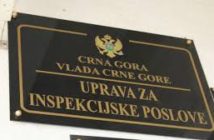Work of the Commission for technical inspection of works on the Bar – Boljare highway and installation of concrete without quality assessment
State Commission for technical inspection of works on the construction of the Bar – Boljare Highway, Section Smokovac – Mateševo, was established in May 2015, after the start of works on the construction of the first section of the highway. It consists of 27 domestic experts and representatives of institutions, who coordinate technical inspection of works performed on the highway. The document establishing the commission stipulates that its work is a business secret, and that none of its members has the authority to disclose any information related to its work and competences.
The Commission, whose work is financed from the budget, sends periodic reports to the Ministry of Transport and Maritime Affairs and the Ministry of Sustainable Development and Tourism, from which MANS requested the reports according to the Law on Free Access to Information, trying to obtain all data related to the devastation of the Tara River caused by the construction of subsection 4.4.1, whose construction site rests for the most part on Tara.
However, both ministries rejected the requests, explaining such decision by the need to protect the “safety of the highway”, but also by the fact that the work of the commission was declared a “business secret”. However, the requested reports on the review of works on the subsection near Tara were eventually submitted by the Business Unit for the project management of the construction of the Bar Boljare highway of the company “Monteput”, which is under the authority of the Ministry of Transport and Maritime Affairs.
When it comes to reports, in its analysis, MANS focused on the actions of the competent commission during control of works on facilities whose construction had a special impact on the Tara River and the area under special UNESCO protection. In this way, special attention was paid to the analysis of reports related to the works on the construction of the bridges Tara 1 and Tara 2, as well as Mateševo loop. A total of 54 reports submitted to MANS according to the Law on Free Access to Information were analysed.
The reports have shown that the construction of subsection 4.4.1 is predominantly performed by China Road and Bridge Corporation (CRBC), while in 2018, when the works began, the company Skladgradnja Split from Croatia was still performing works there, which in the meantime left the job, and CRBC took over its works. Most of the analysed documents contained the commission’s findings on certain shortcomings and non-compliance with recommendations made in previous reports regarding the procedures for the construction of bridges Tara 1 and Tara 2, as well as Mateševo loop, and in only a few reports the commission stated that the works were being carried out in full compliance with the procedure.
Key objections of the Commission for technical inspection of works were:
- the projects of installed concrete and reinforcement are not shown
- the results of ongoing tests of installed materials are not presented
- tests of material did not give satisfactory results; recompression ordered
- no decisions on the selection of the chief engineer were presented
- no decisions on the selection of engineers for individual phases were presented
geological reports are not signed by the designated person for this phase of the project
The biggest discovery was that in September 2018, the commission concluded that “Project of the concrete and construction methodology for the construction of the Tara 2 bridge pillars has not been officially adopted – approved by the engineers/supervisors, although the works on the construction of the pillars are ongoing.” Basically, this means that CRBC performed works on the construction of bridges using concrete for which they did not have an adequate quality assessment, which resulted in an investigative story of MANS, published in April 2019.
You can download a PDF of the full case study here.

